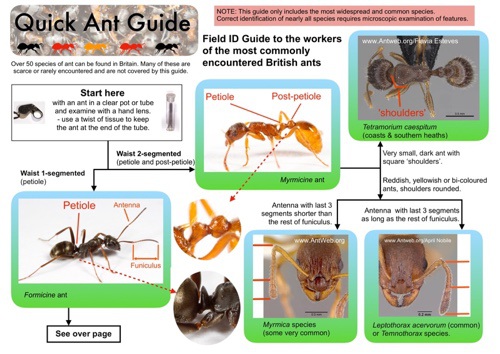01 Oct 2010
Links and other resources for identification of ants in the UK.
Ant Identification Workshops have all finished for 2022.
Any planned for future dates will appear here.
I have put together a Quick ID Guide to ants for beginners courses, but have decided to make it available as a download as well. It is intended to get people looking at ants more closely, and making the first steps towards identifying the species.

Below are some of the resources I find useful for identifying ant specimens from Britain especially, but also Europe. Some of the older keys use out-dated names and/or pre-date the naming of new species. I have put together a list of the main ones, which is at the link below.
Books:
The Ants of Central and Northern Europe.
Bernhard Seifert.
Lutra, 2018.
The most up to date work covering British ants. Technical and difficult
keys (to be honest parts are unuseable for the general naturalist like
me), but otherwise streets ahead of anything else. An essential
reference book.
Ants: The Ultimate Social Insects
Richard Jones
British Wildlife Collection Volume 11
Bloomsbury, 2022.
Full of information on everything to do with ants written in an enjoyable and personal style. Does include an up to date key to British species, but one which I am yet to be convinced about.
Ants
Volume 24 of Naturalists' handbooks, ISSN 0962-6360.
Gary J. Skinner, Geoffrey W. Allen
Company of Biologists, 1996. (Reprints available from Pelagic Publishing)
Out-dated, new species have been added and names changed since 1996. The keys to workers and queens are over-simplified and can be
misleading (uses some poorly defined features, and many of the drawings
are inaccurate or difficult to interpret), the male ant key is probably
best avoided altogether.
The RES Handbook for the identification of British insects;
Vol 6 Part 3c. Hymenoptera - Formicidae.
Barry Bolton & Cedric A. Collingwood.
Is available as a download from the RES website on the out of print handbooks page.
Again needs updating, but the keys are still useful if the changes to
taxonomy since publication are taken into account. Especially useful for
males.
The Formicidae (Hymenoptera) of Fennoscandia and Denmark.
C. A. Collingwood.
Fauna Entomologica Scandinavica, vol. 8, 1979.
Published only a few years after the RES key so similar comments apply,
covers all the British species and not too many others. Useful keys and
line-drawings. Still in print, and also available as a PDF from AntBase.
Ants of Britain and Europe
Claude Lebas, Christophe Galkowski, Rumsaïs Blatrix, Philippe Wegnez.
Bloomsbury Wildlife, 2019.
An English translation of:
Fourmis d'Europe Occidentale.
Delachaux et Nestlé, 2016.
Billed in the English version as 'the first accessible field guide to
the ants of Britain and Europe' and subtitled 'a photographic guide', but this is a bit misleading as the
species photographs provide little help in identification. The
identification keys are good, but as always with ants, require specimens
under a microscope. There is an excellent section on ant ecology and
studying ants, and each species or species group has a detailed
description.
However be warned that the 2019 English language version suffers from some poor
translations ("spine" instead of sting, "gizzard" rather than crop, and a
number of other oddities that don't really make sense. Google Translate
perhaps?).
Websites:
Identification and information resources.
There is lots of useful information and links for British Hymenoptera in general on the BWARS website.
Especially useful for ants are the Stenamma and Myrmica sabuleti/scabrinodis/speciodes guides on the download page.
In 2021 the Cairngorms National Park Authority published an identification guide to the 'wood ants' and similar species of Britain. It has wonderful illustrations by Lizzie Harper and can be downloaded here.
The Key to Identifying Common French Ants (keyants.free.fr) by Claude Lebas had an online dichotomous key to the majority of French species and so covered all the British species. Sadly security issues have led to the site being removed with no information on when or if it will return. Hopefully a way can be found as it was one of the most useful sites on the web.
AntWeb Huge online database of high resolution photos of ants for identification, and more.
Myrmecological News publishes scientific papers on Ants, including many on new species & species identification, and also has a news blog. The latter has also included articles on morphology etc for 'young readers', by which they seem to mean non-ant scientists, so ideal for all the rest of us.
AntWiki With lots of useful stuff. A glossary of morphological terms is here.
Mike Hackston has put together some keys as PDFs based on the RES handbook. The ant ones are available here.
General interest
Mutant - a very quiet ant. (From the Uxbridge English Dictionary)